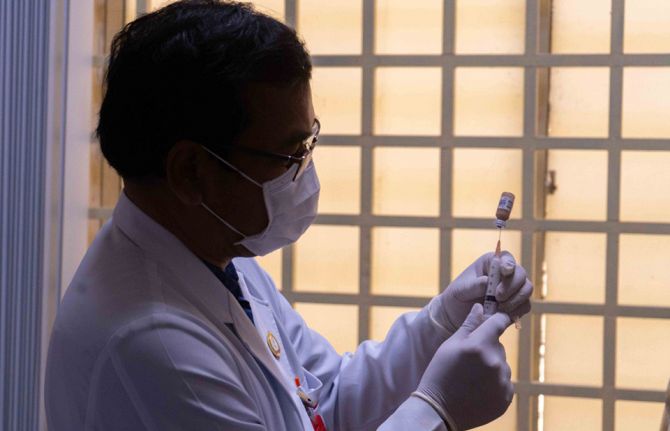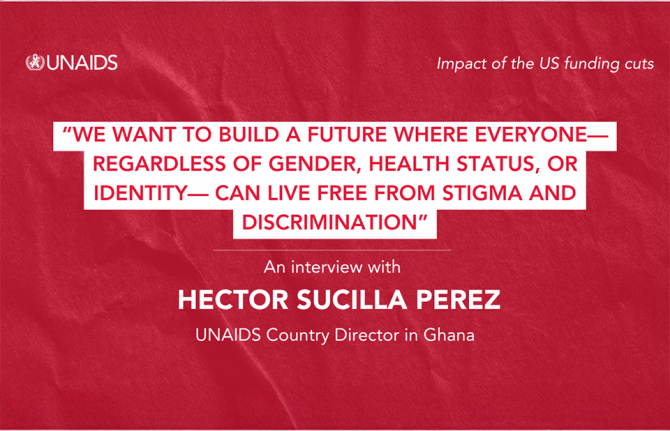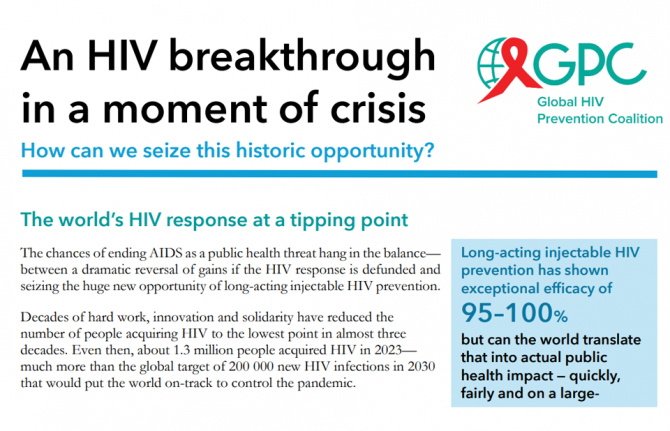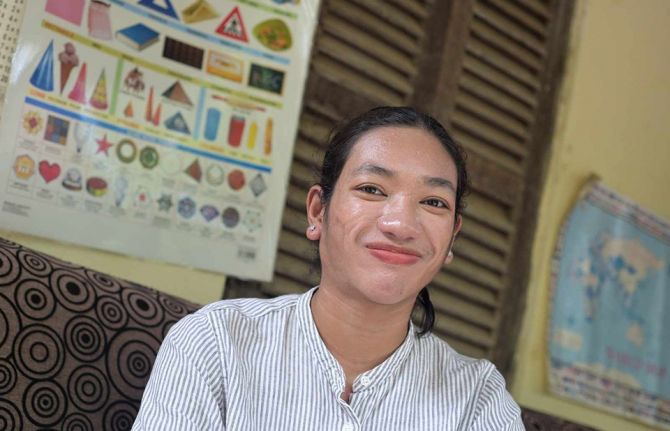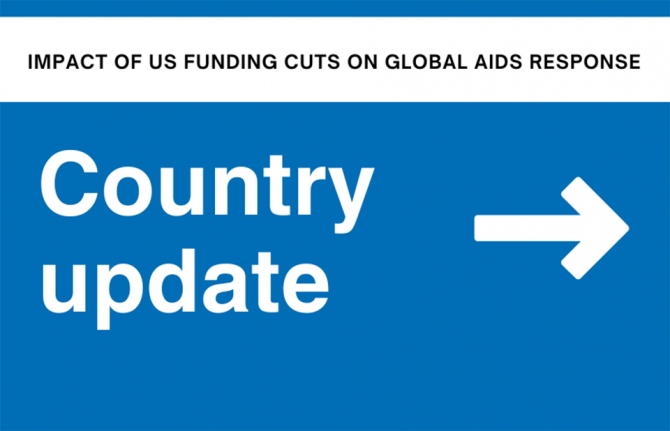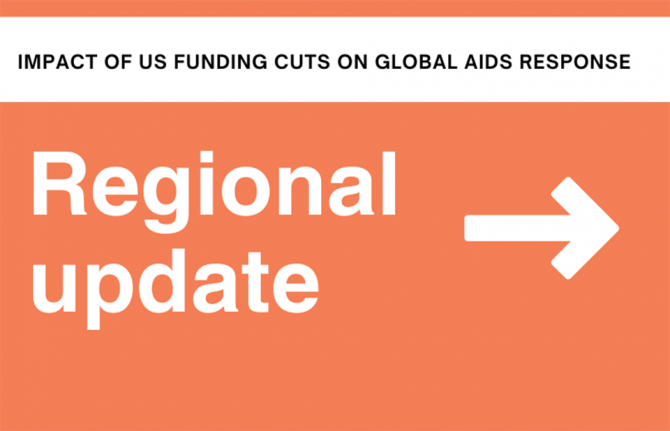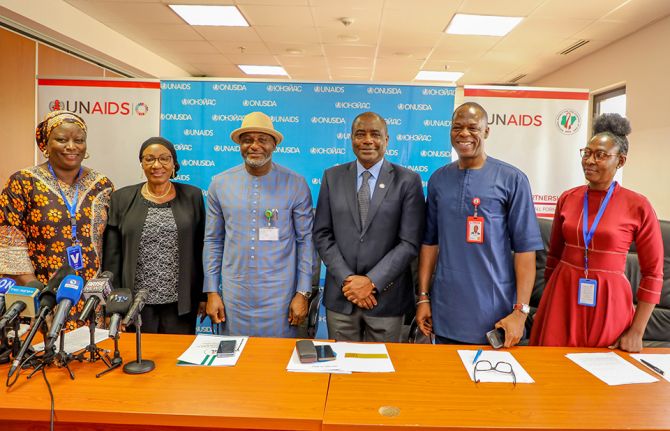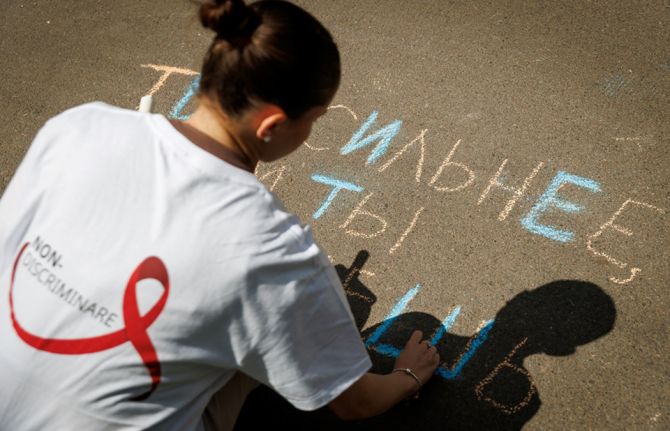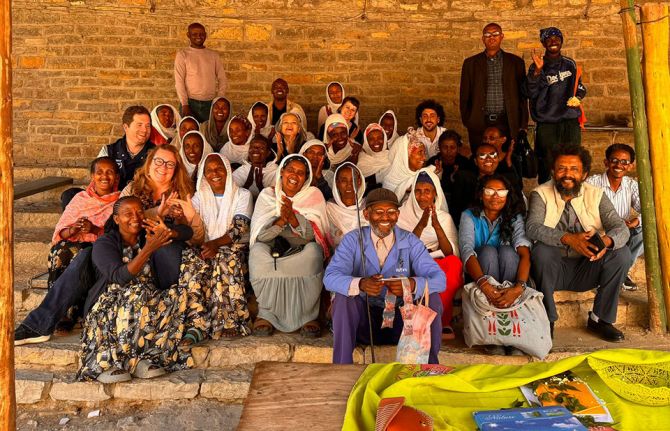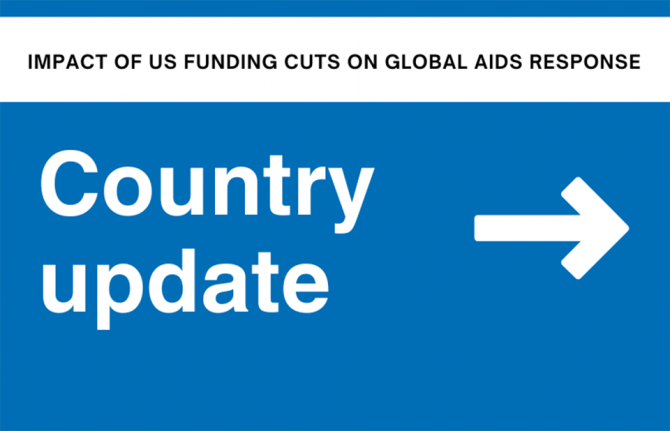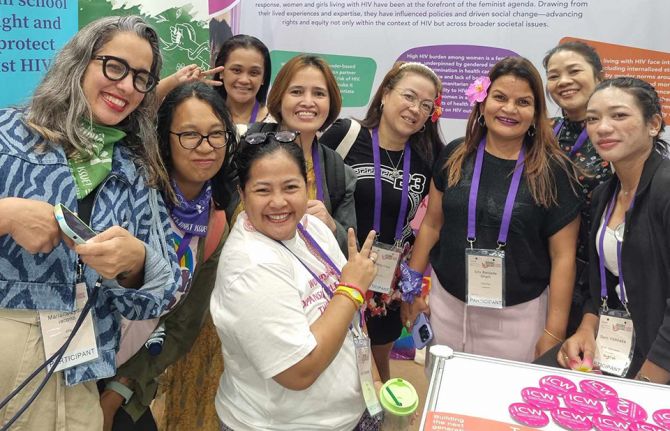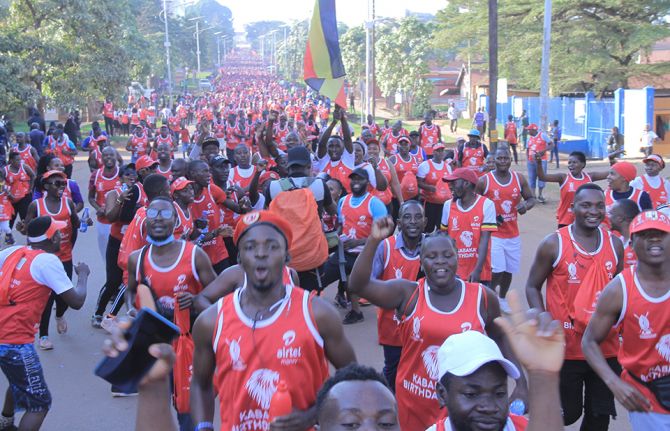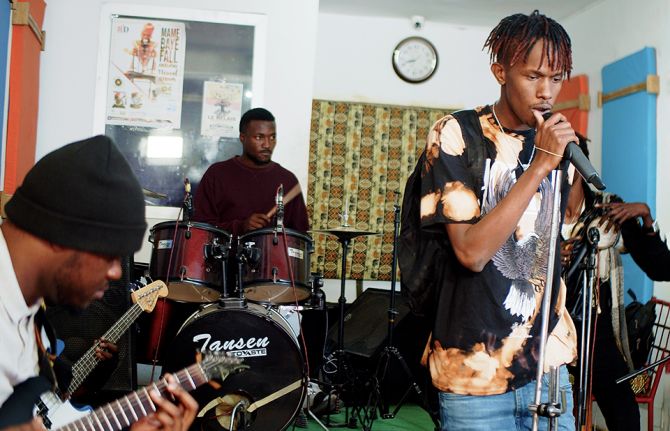
Feature Story
Understanding HIV transmission for an improved AIDS response in West Africa
03 December 2008
03 December 2008 03 December 2008
“West Africa HIV/AIDS epidemiology and response synthesis”
On the opening day of International Conference on AIDS and STIs in Africa (ICASA), taking place in Senegal under the theme “Africa’s Response: Face the facts,” the World Bank launched a new report exploring the character of the HIV epidemics and responses in countries in West Africa.
The “West Africa HIV/AIDS epidemiology and response synthesis” is a review and analysis of surveillance and research data in 15 West African countries: Benin, Burkina Faso, Côte d’Ivoire, Ghana, Guinea, Mali, Niger, Nigeria, Senegal, Togo, Cape Verde, The Gambia, Guinea Bissau, Liberia, and Sierra Leone.
Aiming to gain an improved understanding of HIV transmission dynamics in this sub-region, the paper focuses on the degree to which epidemics in each country are concentrated or generalized, and the implications that this has for effective prevention strategies. The report argues that more prevention focus is needed on the specific groups in which HIV transmission is concentrated, including female sex workers and men who have sex with men.
The new publication highlights a need for better understanding of the complex nature of transactional sex in West Africa. Many women involved in commercial sex do not self-identify as sex workers and have other occupations as well. The boundaries between commercial and non-commercial sex are blurred and it is difficult to have an idea of the proportion of men having commercial sex due to substantial under-reporting.
The importance of men who have sex with men (MSM) in the HIV epidemic in West Africa is being increasingly recognized. High proportions of MSM are also married and/or have sex with other women with very low rates of condom use, acting as a bridge for HIV between MSM and women.
“Know your epidemic. Know your response”
The paper was written as part of the work programme by the World Bank’s Global AIDS Monitoring and Evaluation Team (GAMET) to support countries to “know your epidemic, know your response” so that interventions are carefully chosen and prioritized based on a careful characterization of each country’s epidemic.
Understanding the behaviors that are giving rise to most new infections is a crucial first step to being able to develop a results-focused, evidence-based response that will be effective in preventing new infections. In turn this will improve resource allocation, all the more appropriate when global economic outlook may impact AIDS response.
The work was carried out in partnership between the World Bank and UNAIDS and with the collaboration of the National AIDS Councils and AIDS programmes of the countries.
Understanding HIV transmission for an improved AI
Cosponsors:
Contact:
For more information, please contact: The World Bank Global HIV/AIDS Program Email: wbglobalHIVAIDS@worldbank.org
External links:
Official web site of ICASA 2008
Publications:
The World Bank
West Africa HIV/AIDS Epidemiology and Response Synthesis (pdf, 2.51 Mb)
Related

Feature Story
ICASA 2008: Addressing the vulnerability of young women and girls to HIV in southern Africa
03 December 2008
03 December 2008 03 December 2008On the opening day of ICASA 2008, a new regional report is launched by UNAIDS Executive Director Dr Peter Piot that looks at the vulnerability of women and girls in Southern Africa to HIV.

Dr Peter Piot addresses the launch of the UNAIDS RST report on vulnerability of women and girls in Southern Africa.
Credit: UNAIDS/Jacky D. Ly
Almost two-thirds of all young people with HIV live in sub-Saharan Africa where about 75% of all infections among young people aged 15 to 24 years are among young women.
Responding to the need to understand why young women and girls living in countries in this region are so vulnerable to HIV infection, UNAIDS and the Reproductive Health and HIV Research Unit of the University of Witwatersrand in South Africa convened an expert technical meeting in June 2008.
The meeting agreed four specific sets of actions at community and country levels that are grounded in national strategies and are context specific. The four key actions are:
- Mobilize communities for HIV prevention, with strong male involvement, to design relevant strategies and messages about the causes, consequences of and solutions to young women and girls’ vulnerability
- Expand access to high quality, well-integrated essential sexual and reproductive health and prevention services, while mobilising demand for and use of them.
- Develop and ensure adequate technical and financial resources for implementation of national strategies that address the structural drivers of vulnerability.
- Strengthen country capacities for epidemiological and behavioural surveillance, priority research, and monitoring coverage and impact of prevention responses to generate information to improve decision-making.
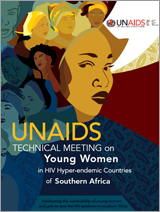
“UNAIDS Technical Meeting on Young Women in HIV Hyper-endemic countries of Southern Africa” was launched on the opening day of ICASA 2008, Dakar.
Participants at the meeting included regional researchers; representatives of national AIDS councils, government departments and the Southern African Development Community; and members of the eastern and southern Africa United Nations Regional AIDS Team. Participants were selected for representation across high-level policy, social and scientific research and programming expertise related to women, girls and HIV, from all countries of southern Africa.
Andy Seale, Senior Regional Adviser for Advocacy and Communications with UNAIDS Regional Support team for Eastern and Southern Africa, said: “A major acceleration in social mobilization, service scale-up, increased resources and better surveillance is needed to successfully address the vulnerabilities explored at the meeting. Actions are needed at all levels from the state level to actions at community, family and individual level.”
The outcomes of that meeting are reflected in a new publication launched by UNAIDS in Eastern and Southern Africa on 1 December 2008 that outlines the experts’ conclusions, recommendations and needed sets of action.
“UNAIDS Technical Meeting on Young Women in HIV Hyper-endemic countries of Southern Africa” also includes a number of the background technical papers which were commissioned for the meeting.
Southern Africa context explored
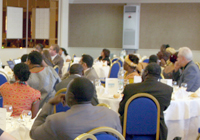
On the opening day of ICASA 2008, a new regional report is launched that looks at the vulnerability of women and girls in Southern Africa to HIV.
Credit: UNAIDS/Jacky D. Ly
The papers explore some of the factors that are driving the current epidemic in southern Africa. These include the practice of age disparate and intergenerational sex; biological vulnerability of young women; economic empowerment; education and gender-based violence. A final paper examines the complex interaction between environmental factors and individual choices, behaviours and community norms.
Improved analyses of these factors will enable appropriate and evidence-informed responses to these specific challenges that increase vulnerability of young women and girls in the region.
Social transformation
Meeting participants called for a social movement to address the drivers that contribute to the risk of HIV infection in the region. Addressing human rights violations, harmful social norms, weak community and leadership capacities are seen as some of the fundamental steps to tackle the vulnerability of young women and girls to HIV in southern Africa.
ICASA 2008: Addressing the vulnerability of young
Feature stories:
New report on the State of the World Population (12 November 2008)
Multimedia:
Interview with Suzanne Leclerc-Mdlala, Human science research council, South Africa (Audio file)
Interview with Susan Kasedde, UNAIDS Regional Adviser East and Southern Africa (Audio file)
External link:
Official web site of ICASA 2008
Publications:
UNAIDS Technical Meeting on Young Women in HIV Hyper-endemic countries of Southern Africa (pdf, 11.3 Mb)
Reaching Common Ground: Culture, Gender and Human Rights - The State of World Population report 2008 (pdf, 2.46 Mb)
Related

Feature Story
ICASA 2008: Africa AIDS conference to look at progress made and challenges ahead
03 December 2008
03 December 2008 03 December 2008
Young women in Dakar, Senegal. Credit: UNAIDS/P.Virot
Sustaining the progress that has been made in preventing new HIV infections and getting more people on antiretroviral treatment are priorities for African countries if they are to get ahead of the AIDS epidemic in the coming years – this is the overarching theme to be discussed at the 15th International Conference on AIDS and STIs in Africa (ICASA) taking place in Dakar, Senegal from 3 to 7 December 2008.
The theme of Africa's leading forum for discussion of HIV developments and trends is “Africa’s Response: Face the facts”.
Experts from UNAIDS, together with many from international and African organizations, civil society groups including people living with HIV, media, and other partners in the AIDS response, will take part in five days of sessions and open forums that will review the successes and challenges to date in Africa’s AIDS response. In particular, international and African experts will evaluate the current state of the HIV and other sexually transmitted infections (STIs) epidemics, assessing political commitments, scientific progress and challenges, community actions, and leadership.
“The AIDS epidemic is not over in any part of Africa,” said UNAIDS Executive Director Dr Peter Piot, who will open ICASA and engage in a number of events, many focused on leadership and youth engagement. “As African countries plan their next steps in addressing AIDS, it is necessary to now take stock of successes and challenges”.
UNAIDS Deputy Executive Director Michel Sidibe, UN Special Envoy Lars Kallings (for Eastern Europe and Central Asia), UNAIDS Special Representatives HRH Princess Mathilde of Belgium and Gaetano Kagwa, as well as several other prominent advocates will be present and contribute to the discussions.
Several sessions are being devoted to ‘knowing your epidemic and your response’, human rights based approaches, including tackling stigma and discrimination, addressing women’s and girl’s vulnerabilities, the role of religion and faith-based organizations, public-private partnerships, technical support to countries, tuberculosis and HIV, and financial mechanisms.
Africa’s AIDS Response
The conference is happening at a unique phase in Africa’s epidemics: the global financial and economic crisis, continued poverty and inequalities pose challenges and obstacles for countries as they find innovative solutions to reducing new HIV infections, curbing AIDS deaths, and getting more people on treatment.
Sub-Saharan Africa remains the region in the world most heavily affected by HIV – there are about 22 million [20.5–23.6 million] people living with HIV in the region.
In 2007, the region accounted for two thirds (67%) of all people living with HIV and for three quarters (75%) of AIDS deaths globally. And AIDS continues to be the leading cause of death in Africa. The nine countries in southern Africa continue to bear a disproportionate share of the global AIDS burden with 35% of HIV infections and 38% of AIDS deaths in occurring in the region.
Despite these sobering figures, progress made over the past few years show that the there are returns on investments in HIV prevention and treatment programmes. As reported in the UNAIDS 2008 Report on the global AIDS epidemic, in a number of heavily affected countries, such as Rwanda and Zimbabwe, changes in sexual behaviour have been followed by declines in the number of new HIV infections. Behaviours include waiting longer to become sexually active, fewer multiple partners, and increased condom usage among people with multiple partners.
UNAIDS and its partners are working with countries to build on HIV prevention results and encourage the implementation of combination HIV prevention as a priority approach – selecting the right mix of behavioural, biomedical and structural HIV prevention actions and tactics to suit epidemics and the needs of those most at risk. National AIDS programmes must also continue to address the factors that continue to put women and girls at risk, while at the same time heighten HIV prevention awareness for other most-at-risk groups, such as sex workers and men who have sex with men.
ICASA is expected to draw around 5,000 participants from a range of countries and backgrounds.
ICASA 2008: Africa AIDS conference to look at pro

Feature Story
ICASA 2008: Courage and Hope, African teachers living positively
03 December 2008
03 December 2008 03 December 2008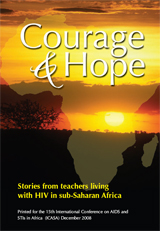
An estimated 122,000 teachers in sub-Saharan Africa living with HIV have been given voice in a collaborative project by UNAIDS Cosponsor the World Bank and African Ministries of Education networks of HIV/AIDS focal points.
An estimated 122,000 teachers in sub-Saharan Africa living with HIV have been given voice in a collaborative project by UNAIDS Cosponsor the World Bank and African Ministries of Education networks of HIV/AIDS focal points. The result is a book and a documentary film produced by Partnership for Child Development with support by the World Bank.
On the opening day of ICASA the African premiere screening and launch of the documentary “Courage and Hope” took place in Dakar. Don Bundy, World Bank Lead Specialist on School Health HIV/AIDS & Education introduced the film and its background.
After hearing at an education summit in 2006 how teachers living with HIV in Gabon were returning to their classrooms thanks to HIV treatment and playing new leadership roles in fighting the disease, Bundy encouraged the World Bank and the Partnership for Child Health to finance Courage and Hope.
“This kind of support for teachers helps both maintain the trained workforce and provides young people with credible adult role models,” says Bundy.
Elizabeth Lule, Manager of ActAfrica described how children have a chance to live a life free from HIV if they can acquire knowledge, skills, and values that will help protect them as they grow up. “Providing young people, especially girls, with the ‘social vaccine’ of education offers them a real chance at a productive life, free of HIV,” she said.
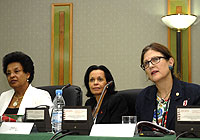
(from left): Debrework Zewdie and Elizabeth Lule from the World Bank and Barbara de Zalduono of UNAIDS speak to participants at the launch of Courage and Hope. Credit: UNAIDS/Mamadou Gomis
In the book twelve teachers from Burkina Faso, Cameroon, Ghana, Kenya, Mozambique, Rwanda, Senegal, Tanzania mainland, Zanzibar and Zambia vividly recount their experiences that testify to ordinary yet courageous life with HIV and the impact their HIV status has on their loves, families, schools and communities.
The vast majority of teachers living with HIV in sub-Saharan Africa are unaware of their positive status, and many are reluctant to undergo HIV testing for fear of consequences of a positive test outcome.
In the film four of the teachers—Beldina Atieno, Martin Mkug Ptoch, Jemimah Nindo, and Margaret Wambete—detail the challenges they faced once their positive status became public. These range from stigmatization to shunning and discrimination against them and their families.
“HIV does not kill. What kills is the stigma and discrimination associated with the virus,” says Beldina Atieno, a 38 year-old teacher from Kenya who learned the hard way how to cope with discrimination after being thrown out of the house by her husband and losing her children as well as her job.
Despite the personal hurdles the teachers faced, they are confident that accessing effective care, support and anti retroviral medicines, they are able to live, and to enjoy full and healthy lives. The personal reflections of these teachers offer courage and hope to the other estimated 121,996 teachers living with HIV in sub-Saharan Africa.
“Courage and Hope” film trailer
The film “Courage and Hope: African Teachers Living Positively with HIV” was first shown at the International AIDS Conference 2008 in Mexico and broadcast from the UNAIDS booth, where free copies of the DVD were also distributed.
At the Dakar launch, Martin Ptoch, who is a teacher living with HIV featured in the film described the positive reactions to the film and book to date. Barbara de Zalduondo, Chief, Programmatic Priorities and Support UNAIDS and Debrework Zewdie, World Bank, Global HIV/AIDS Program also spoke at the launch.
ICASA 2008: Courage and Hope, African teachers li
Cosponsors:
World Bank
World Bank HIV and education
Multimedia:
Watch the trailer for “Courage and hope” on You Tube
External links:
Contact:
Copies of the DVD and book can also be obtained from the Partnership for Child Development.
Email: pcd@imperial.ac.uk
A broadcast version of the film is available from Baney Media
Email: daphne@baneymedia.com
Publications:
UNAIDS Inter-Agency Task Team on Education advocacy briefing note: Teachers living with HIV (pdf, 274 Kb)

Feature Story
ICASA 2008: Collaborative TB and HIV activities essential
03 December 2008
03 December 2008 03 December 2008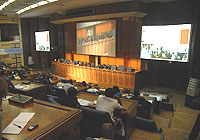
A satellite symposium to highlight the impact that TB has on people living with HIV was held on 3 December 2008 during ICASA. Credit: UNAIDS/Mamadou Gomis
TB is among the leading causes of death in people living with HIV and accounts for an estimated 13% of AIDS deaths worldwide. HIV and TB are so closely connected that they are often referred to as co-epidemics or dual epidemics. Each worsens the impact of the other, yet despite evidence of positive impact of joint interventions, TB and HIV programmes have largely been implemented independently.
Sub-Saharan Africa carries the highest burden of HIV infections and AIDS related mortality in the world, accounting for more than 60% of people living with HIV worldwide. On average, 22% of TB patients in the Region are co-infected with HIV, and approximately 40% of TB deaths are due to HIV.
TB is the most common cause of illness and death among people living with HIV in Africa, despite being preventable and curable. Rising rates of drug resistant TB, especially extensively drug resistant tuberculosis (XDR-TB), further threaten the response to AIDS in the region.

Alasdair Reid, UNAIDS HIV/TB Adviser
Credit: UNAIDS/Mamadou Gomis
For these reasons, on Wednesday 3 December UNAIDS, WHO and WFP in collaboration with the TB/HIV working group of the Stop TB Partnership organized a satellite symposium to highlight the impact that TB has on people living with HIV and what needs to be done to reduce this unnecessary burden of illness and death.
The symposium underlined what needs to be done by HIV programmes and civil society to improve the prevention, diagnosis and treatment of TB in people living with HIV. It introduced the ‘Three I’s for HIV/TB’, a package of interventions - including Intensified TB case finding (TB screening), Isoniazid preventive therapy and Infection control - that aim to reduce the burden of TB among people living with HIV. Furthermore, the need to jointly address nutrition as an essential element in the response to TB and HIV was promoted. TB and HIV both compromise the nutritional status of affected persons, leading to malnutrition, which in turn aggravates the severity of HIV and TB.
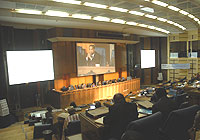
Credit: UNAIDS/Mamadou Gomis
Few countries have comprehensive plans to reduce the burden of TB among people living with HIV in the region. The consequence is that the coverage with key TB and HIV interventions is still very low. Collaborative TB/HIV activities are essential to ensure that TB patients living with HIV are able to access HIV testing and treated appropriately, and to effectively prevent, diagnose and treat TB in people living with HIV.
In 2006, only 22% of TB patients were tested for HIV in sub-Saharan Africa, and less than 1% of people living with HIV were screened for TB disease.
The symposium demonstrated the need for rapid scale up to ensure universal access to TB prevention, diagnosis and treatment services for people living with HIV in Africa.
“The ICASA symposium has helped to enhance the engagement of HIV service providers and affected communities in the implementation of these crucial interventions and strengthen collaboration between TB programmes, HIV programmes and civil society,” said Alasdair Reid, UNAIDS HIV/TB Adviser.
ICASA 2008: Collaborative TB and HIV activities e
External links:

Feature Story
UNHCR reflects on progress and remaining challenges on World AIDS Day
02 December 2008
02 December 2008 02 December 2008UNHCR marked World AIDS Day by reflecting on successes in the agency’s AIDS response while recognizing that there is still a long way to go. UNHCR is a cosponsor of the Joint United Nations Programme on HIV/AIDS (UNAIDS).
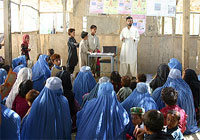
Afghan refugee returnees from Pakistan attend an awareness session on HIV at a UNHCR transit centre. Credit: UNHCR/M.Maguire
A senior UNHCR official said on Monday that while the UN refugee agency had made progress in responding to the challenges of HIV among displaced populations in recent years, there is still a long way to go.
“UNHCR’s HIV and AIDS programmes have come a long way,” said Arnauld Akodjenou, head of UNHCR’s Division of Operational Services, in a special World AIDS Day message for staff. “HIV remains one of the policy priorities of the High Commissioner [for Refugees António Guterres] and protection remains the cornerstone of UNHCR’s HIV and AIDS strategy.”
Akodjenou noted that “Today, we have reached nearly 100 percent coverage in universal precautions in health clinics in refugee camps and safe blood supply to refugees; [while] access to programmes for prevention of mother-to-child transmission increased to more than 60 percent.”
Universal precautions refers to the medical practice, of avoiding contact with patients' bodily fluids such as wearing gloves when collecting or handling blood and body fluids.
He also revealed that anti-retroviral therapy is now available to UNHCR beneficiaries in many refugee camps, and that its coverage for refugees increased to 75 percent in 2008.
But serious challenges remain. “We need to scale up efforts in HIV prevention, care and treatment for our staff, refugees and other persons of concern. We need to work closer with communities to develop community-based HIV prevention and care initiatives while continuing to tackle stigma and discrimination towards people living with HIV. We also need to ensure medical confidentiality in all circumstances,” said Akodjenou.
“Each of us should contribute in our own way to fighting HIV and AIDS. This may include advocating for the inclusion of refugees and other displaced persons in national HIV policies and programmes, tackling the social and economic inequalities and injustices, and protecting and promoting human rights.”
As part of a larger campaign to ensure that policymakers keep their promises on AIDS, this year’s World AIDS Day theme is "Lead – Empower – Deliver." UNHCR offices around the world marked the occasion with a range of events, and many offices reflected on the success of current programmes – such as the launch of a major awareness and prevention campaign in south-east Democratic Republic of the Congo (DRC).
The landmark campaign in Katanga province kicked off in October, when a travelling roadshow visited the town of Moba, on Lake Tanganyika, and the surrounding areas. Staff from UNHCR and partner organizations distributed information about HIV, provided training and offered locals free HIV testing and counselling.
Since 2006, when UNHCR set up field offices in Katanga, tens of thousands of people have returned to their homes from overseas or other parts of the province. But they remain at risk to disease, including HIV, said Philippe Creppy, head of UNHCR’s Moba office.
The campaign in Katanga, which will enlist the help of traditional chiefs and local health workers, will spread awareness about the vital importance of prevention and will also encourage people to take part in free HIV testing and counseling services. The young will be a particular focus. UNHCR will also work with civil society to design and implement HIV programmes.
Creppy said UNHCR and its partners hoped that free counselling and testing, together with the training of medical staff and the development of health facilities and comprehensive policies, would help “put the brakes on the rapid development of this scourge in the territory.” Those who test positive for HIV and who need treatment will receive anti-retroviral drugs.
The campaign, involving more than a dozen non-governmental organizations, will gradually be extended to the rest of the DRC and is scheduled to last five years.
UNHCR reflects on progress and remaining challeng
Cosponsors:

Feature Story
UN Cares: UN system workplace programme on HIV launched in Asia Pacific
02 December 2008
02 December 2008 02 December 2008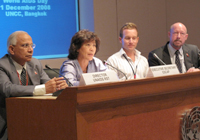
(from right) Mr Geoff Manthey (Regional Programme Advisor); Mr Robert Sutherland (UN+ representative); Ms Heyzer (Executive Secretary, ESCAP) and Mr Prasada Rao (UNAIDS Regional Support Team Director) at the World AIDS Day launch. United Nations Convention Center, Bangkok, Thailand. 1 December 2008Credit: UNAIDS
Marking World AIDS Day, UN staff from the Asia Pacific region launched a “UN Cares” regional programme yesterday in Bangkok.
Robert Sutherland, representative of UN Plus in Asia and the Pacific, delivered a speech at the launch in which he acknowledged his appreciation of the leadership of UN agencies in delivering on AIDS, and appealed for even more support for creating an environment free of stigma and discrimination within UN.
After the lighting of two red candles – which according to Asian tradition marks a beginning – the UN Under Secretary-General and Executive Secretary ESCAP, Ms. Noeleen Heyzer delivered her address. She stressed the role of a coordinated “one UN” to ensure that the UN Secretary-General’s commitment to UN Cares is realized in the region. She said, “This year’s World AIDS Day theme ‘Lead, Empower, Deliver’ allows us to reflect on our roles as UN leaders. With this theme, let us pledge to contribute to our own staff welfare when it comes to HIV and AIDS by ensuring time and support needed to meet a specific set of ten minimum standards of UN Cares by the end of 2011.”
On the occasion, the UN Cares Asia-Pacific Regional Coordinator, Dr Lazeena Muna-McQuay was introduced. Dr Muna-McQuay is jointly hosted by UNFPA, ESCAP and UNAIDS RST.
Two UN Cares videos were screened during the programme including the speech of Secretary-General during the official launch of global UN Cares programme and the “voices of support from the field”.
The launch closed with a commitment, as iterated by the Secretary-General, to make UN Cares ten Minimum Standards achieved by all UN agencies by the year 2011.
UN Cares
The UN Cares programme has been developed through interagency consultation between UNAIDS Cosponsors and other. It is a single harmonized programme available to UN system personnel and their families in all entities and all duty stations, designed to help them to access their rights defined in the 1991 United Nations HIV/AIDS Personnel Policy and in the ILO Code of Practice on HIV/AIDS and the World of Work and recognize their individual responsibilities related to HIV. The UN Cares global programme was launched by the Secretary-General in May this year in New York.
UN Cares: UN system workplace programme on HIV la

Feature Story
UNAIDS Washington commemorates 20th Anniversary of World AIDS Day
01 December 2008
01 December 2008 01 December 2008In commemoration of this year’s World AIDS Day the UNAIDS Office Washington, in partnership with UNAIDS partners, cosponsors and local civil society organizations, is holding a week-long World AIDS Day visit for women living with HIV from India, Swaziland and the US.
The visiting participants are: Beri Hull, from the USA, who is North America representative of the International Community of Women Living with HIV and AIDS; Jahnabi Goswami from India who is general secretary, INP+ the national Network of People Living with HIV; and Thembi Nkambule of Swaziland who is national coordinator of Network of Women Living with HIV, Swaziland. All three lead education and advocacy efforts in their respective countries.
The three women hope through sharing their stories of courage, determination and selfless service to their communities they inspire leaders who will become champions on issues regarding women and AIDS.
The visit began yesterday in Washington, DC. Today a World AIDS Day luncheon commemorating the 20th Anniversary of World AIDS Day is being held at the National Press Club. Michele Moloney-Kitts, assistant coordinator, Office of the U.S. Global AIDS Coordinator and Tim Wirth, former U.S. senator and President, UN Foundation and Better World Campaign will also address this event.
On 3 December, the Global AIDS Alliance, UNAIDS, and participants will travel to Rock Hill, South Carolina for a two-day HIV awareness-raising tour, which is designed to educate and inform audiences about the role UNAIDS and the participants play in the global AIDS response. The visit will emphasize the need for effective leadership and AIDS solutions tailored to work for specific epidemics, including helping women and girls.
UNAIDS Washington commemorates 20th Anniversary o
Feature stories:
Get ready for World AIDS Day 2008 (27 October 2008)
External links:
World AIDS Campaign
ICW (International Community of Women living with HIV/AIDS)
INP+ (National Network of People Living with HIV, India)
Publications:

Feature Story
World AIDS Day 2008
01 December 2008
01 December 2008 01 December 2008
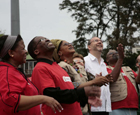 Dr Peter Piot, Executive Director of UNAIDS, is marking the 20th World AIDS Day at a ceremony in Durban, together with South Africa’s Deputy President, Ms Baleka Mbete and South African Health Minister Barbara Hogan.
|
|
|
|
|
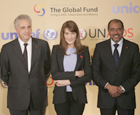 The appointment of Ms Carla Bruni-Sarkozy as Ambassador for the Protection of Mothers and Children Against HIV/AIDS of the Global Fund to Fight AIDS, Tuberculosis and Malaria is welcomed by UNAIDS. Deputy Executive Director Michel Sidibé was present at today’s event in Paris.
|
|
|
|
|
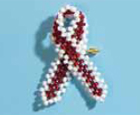 1 December 2008 marks the 20th anniversary of World AIDS Day. This year’s theme is “Lead – Empower – Deliver.” To mark the day, the United Nations Secretary General, the Executive Director of UNAIDS and our Cosponsors and partners speak out in special World AIDS Day statements.
|
|
|
|
|
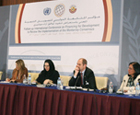 As leaders gather in Qatar's capital, Doha, to take stock of the implementation of the 2002 Monterey Consensus on financing for development World AIDS Day 2008 is marked with a press conference and statement from the UN Secretary-General Ban Ki-moon.
|
|
|
|
|
 Giant red ribbons displayed on Olympic Stadium to inspire the response to AIDS in China and beyond
|
|
|
|
|
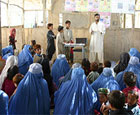 UNHCR marked World AIDS Day by reflecting on successes in the agency’s AIDS response while recognizing that there is still a long way to go. UNHCR is a cosponsor of the Joint United Nations Programme on HIV/AIDS (UNAIDS).
|
|
|
|
|
 Celebrating women of courage in Washington D.C.
|
|
|
|
|
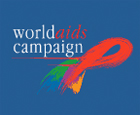 Sara Speicher of the World AIDS Campaign explores the history of this annual event focus of global solidarity for a pandemic that has led to over 25 million deaths with an estimated 33 million people currently living with HIV worldwide.
|
|
|
|
|
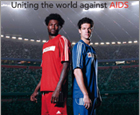 "On the pitch we compete – off the pitch we are uniting the world against AIDS" These are the messages behind a new Public Service Announcement and poster campaign that UNAIDS is launching featuring UNAIDS Goodwill Ambassador Michael Ballack and fellow star footballer Emmanuel Adebayor. In the game of football, the two players are fierce rivals, each representing the competing Premier League football clubs Arsenal and Chelsea. On they pitch they play hard to win - but off the pitch they are Uniting the World Against AIDS. UNAIDS and Michael Ballack, who has worked with UNAIDS in his role as UNAIDS Goodwill Ambassador since 2006 to raise awareness on HIV prevention, are pleased to have Emmanuel Adebayor join the ongoing effort of Uniting the World Against AIDS. |
|
|
|
|
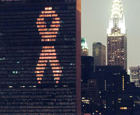 UNFPA Goodwill Ambassador Mpule Kwelagobe was among the guests who gathered last night to holding a commemoration at the Riverside Church, New York. UNAIDS, UNFPA and IAWG welcomed members of the public, community leaders, community-based and national organizations and the World AIDS Campaign in an evening of reflections, candlelight remembrance and followed by a community reception.
|
|
|
|
|
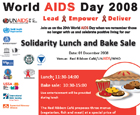 Geneva in solidarity
|
|
|
|
|
 AIDS Outlook is a new report from UNAIDS that provides perspectives on some of the most pressing issues that will confront policymakers and leaders as they respond to the challenges presented by AIDS in 2009.
|
|
|
|
|
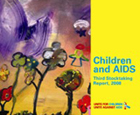 Early diagnosis and treatment can significantly improve the prospects for survival of newborn babies exposed to HIV, according to a report released today by four United Nations agencies.
|
|
|
|
|
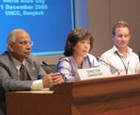 Marking World AIDS Day, UN staff from the Asia Pacific region launched a “UN Cares” regional programme yesterday in Bangkok.
|
|
|
|
|
 Today, on 20th anniversary of World AIDS Day, the UNAIDS competition featuring superstar football player and UNAIDS Special Representative Michael Ballack has come to a close.
|
|
|
|
|
 The International Cricket Council (ICC) will celebrate five years of raising awareness and reducing the stigma of HIV by running a series of activities to mark World AIDS Day on 1 December. Players taking part in major international matches will wear red ribbons, as a global show of support for people living with HIV, while the India and England teams will meet young people affected by HIV ahead of the seventh ODI in Delhi. “The UNAIDS-ICC partnership is a good example of promoting social responsibility through sport,” said Michel Sidibe, Deputy Executive Director of UNAIDS. “The game of cricket and its players have helped to raise awareness about HIV among young people and to break down barriers of stigma in many countries,” he said. |
|
|
|
|
 The theme of this year’s World AIDS Day is “Leadership.” Throughout 2008 the World AIDS Campaign invited people from around the world to make their pledge of personal commitment.
|
|
|
|
|
 UNESCO offices from Almaty to Yaoundé are organizing a wide range of activities, building on the theme of ‘leadership’ and the Organization's longstanding work on HIV.
|
|
|
|
|
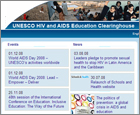 UNESCO has launched a redesigned a HIV Education Clearinghouse, an online library and knowledge sharing initiative, providing an interface in English, French and Spanish to technical resources on Education and HIV & AIDS.
|
|
|
|
|
 The International Labour Organization is hosting an exhibition of Zimbabwe sculptures by artists affected by HIV. It is also highlighting the progress made towards the adoption of the new labour standard on HIV and the world of work. A training workshop will run until 3 December on "Driving for Change: Training Toolkit on HIV/AIDS for the road transport sector", jointly organized by the ILO, the International Road Transport Union and the International Transport Workers' Federation. |
|
|
|
|
 To mark the 10th Anniversary of MTV’s Staying Alive Campaign they’ve launched a great new website with lots of new features including a Twitter feed as well as a commenting system so that you can have your say on any of the issues discussed on the site. Lots more video content and photos too!
|
|
|
|
|
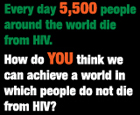 To mark World AIDS Day the International HIV/AIDS Alliance asked people to share their views on this question. People from all over the world responded including leaders like Archbishop Desmond Tutu, Dr Peter Piot UNAIDS Executive Director, Gordon Brown UK Prime Minister.
|
|
|
|
|
 Ahead of World AIDS Day 2008, two sculptures by Keith Haring have come to UNAIDS to join the “Art for AIDS” collection. His iconic and poignant work has been instrumental in raising awareness around AIDS issues worldwide.
|
|
|
|
|
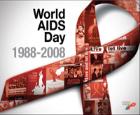 27 October 2008 Together with its partners, the World AIDS Campaign has set this year’s theme for World AIDS Day as “Lead – Empower – Deliver”, building on last year’s theme of “Take the Lead”. Designating leadership as the World AIDS Day theme for 2007 – 2008 provides an opportunity to highlight both the political leadership needed to fulfill commitments that have been made in the response to AIDS – particularly the promise of universal access to HIV prevention, treatment, care and support by 2010 – and celebrating the leadership that has been witnessed at all levels of society. |
World AIDS Day 2008
Cosponsors on
World AIDS Day
UNHCR
UNFPA
WFP
UNDP
UNODC
ILO
World Bank
UNESCO
WHO
UNICEF
External links:
World AIDS Campaign
United Nations in New York
Press centre:
Giant red ribbons displayed on Olympic Stadium to inspire the response to AIDS in China and beyond (30 November 2008)
New HIV incidence analyses helps sharpen prevention efforts (28 November 2008)
Multimedia:
View B-roll video for download
View photos from World AIDS Day events around the world

Feature Story
Third stocktaking report on children and AIDS
01 December 2008
01 December 2008 01 December 2008
The report, titled Children and AIDS: Third stocktaking report, was jointly prepared by UNICEF, the World Health Organization (WHO), the Joint United Nations Programme on HIV/AIDS (UNAIDS) and the United Nations Population Fund (UNFPA).
Early diagnosis and treatment can significantly improve the prospects for survival of newborn babies exposed to HIV, according to a report released today by four United Nations agencies.
The report, titled Children and AIDS: Third stocktaking report, was jointly prepared by UNICEF, the World Health Organization (WHO), the Joint United Nations Programme on HIV/AIDS (UNAIDS) and the United Nations Population Fund (UNFPA).
This report is the third review of progress on how AIDS affects children and young people since the Unite for Children, Unite against AIDS campaign was launched in October 2005 by UNICEF, UNAIDS and other partners with a commitment to be accountable for results.
Unite for Children, Unite against AIDS is a call to action around the impact of HIV and AIDS on children. It focuses on the needs of children in four key areas, known as the “Four Ps”: Preventing mother-to-child transmission of HIV; Provision of paediatric treatment; protection and support of children affected by AIDS; and prevention of infection among adolescents and young people.
This 2008 Stocktaking Report examines data on progress, emerging evidence, and current knowledge and practice for children as they relate to the four programme areas. The report also calls for actions in the next one to three years that can significantly improve prospects for children and women affected by AIDS. These initiatives involve changes in thinking, as well as concrete actions.
Prevention of mother-to-child transmission of HIV
Most pregnant women diagnosed with HIV do not have access to essential care and treatment, including antiretroviral therapy for their own health, to further reduce HIV transmission and prevent orphaning, according to the new report. Far too few pregnant women know their HIV status. In 2007, only 18% of pregnant women in low- and middle-income countries where data were available were tested for HIV, and of those who tested positively for HIV, only 12% were further screened to determine the status of the HIV disease and the type of treatment they require. Addressing mothers’ needs for diagnosis and treatment will improve not only their own overall health but their children’s survival.
Providing paediatric treatment and care
The report found that children under the age of one are not getting diagnosed and are missing out on treatment. As a result, large numbers of very young children are dying every year due to AIDS-related illnesses. Recent evidence found mortality levels reduced by up to 75% when infants were tested early and treated within the first 12 weeks of life. In 2007, however, only 10% of children born to HIV-positive women were tested before they were two months old. Therefore, the report advocates for increased testing to enable appropriate treatments to begin as early as possible.
Protection and care for children affected by AIDS
There is growing evidence in support of programming that addresses the wider context of children’s vulnerability as the basis to assist those children, families and communities directly affected by AIDS. The stocktaking report highlights that responses should be AIDS-sensitive and not AIDS-exclusive. While support to strengthen family and community responses to the epidemic remains a high priority, there is recognition of the need to support national protection systems, including government capacity to address child welfare generally.
Preventing infection among adolescent and young people
Significant numbers of young people continue to be infected with HIV each year, and girls in sub-Saharan Africa, in particular, remain vulnerable – 45% of all new infections occur in the 15–24 year-old age group. The new report argues that urgent attention is needed to address the greater HIV risks to girls of multiple concurrent partnerships, intergenerational sex, transactional sex and gender-based violence.
In countries with low-prevalence and concentrated epidemics, HIV prevention responses focused on adolescent risk behaviours – including injecting drug use, unprotected sex between males, and sex in exchange for gifts and money – are a priority. There is strong consensus that combination prevention programmes – integrating behavioural, structural and biomedical approaches – work.
This year’s report is accompanied by ‘Children and AIDS: Country Fact Sheets’, which present key statistical data on the “Four Ps” for 157 countries.
Third stocktaking report on children and AIDS
Cosponsors:
Press centre:
Early HIV Testing and Treatment Can Save Newborn Lives, New U.N. Report Released on World AIDS Day States (pdf, 80 Kb)
Feature stories:
Second stocktaking report on children and AIDS (03 April 2008)
Signs of progress in global response to Children and AIDS (16 January 2007)
External links:
Unite for Children, Unite against AIDS
Publications:
Children and AIDS: Third stocktaking report (pdf, 1.9 MB)
Children and AIDS: Third stocktaking report Summary (pdf, 2.71 MB)
Related
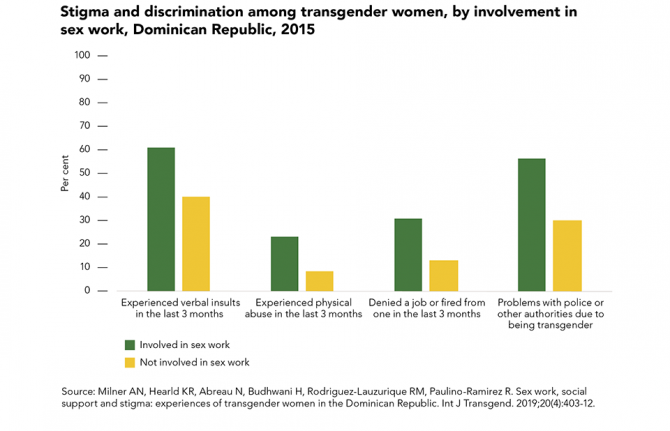 Transgender sex workers face frequent abuse
Transgender sex workers face frequent abuse

29 March 2022
 Many key populations avoid health services
Many key populations avoid health services

21 February 2022

